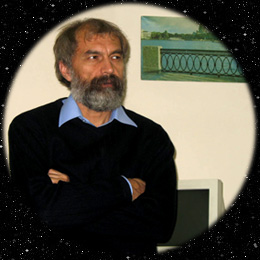
|
|
|
| Vladimir V. Vechernin | |
 | |
| I am interested in microscopic model of cumulative phenomena in nuclei, x>1 perturbative light-front QCD near thresholds soft contributions summed using recurrence relations several partons conspire to produce high x particle formation rates for fast quarks in presence of sea quarks in a nucleus hadronization mechanism of fast cumulative quarks multi-nucleon short-range correlations in nuclei mathematical modeling of the complex biological systems. | |
| The plan of investigations | |
|
Recently we (Prof. M. A. Braun and me) have proposed a microscopic model of the cumulative phenomena in nuclei, i.e. the processes kinematically forbidden for scattering from a free nucleon, including the nuclear structure functions and particle production at values of the Bjorken-Feynman scaling variable x>1 in high energy hA-collisions: [Braun M.A. and Vechernin V.V. Nuclear Structure Functions and Particle Production in the Cumulative Region in the Parton Model. Nucl. Phys. B (1994) B427 614-640]. See also [Braun M.A. and Vechernin V.V. Structure Functions and Particle Production in the Cumulative Region: two different exponentials. Physics of Atomic Nuclei (1997) 60 no.2; E-preprint: hep-ph 9601315, 1996, 14p.], [Braun M.A. and Vechernin V.V. Cumulative Phenomena through the Quark-Parton Diagram Summation at Thresholds. E-preprint: hep-ph 9612273, 1996, 13p.] The model is based on perturbative light-front QCD calculations of the corresponding quark-parton Feynman diagrams near the thresholds, where some partons turn soft. To sum all diagrams like these he has developed the special technique based on the recurrence relations.
Proposing this model we have used the observation of the paper [S.J.Brodsky, P.Hoyer, A.H.Mueller
and W.K.Tang New QCD production mechanisms for hard processes at large x. Nucl. Phys. B369 (1992)
519] on the possibility to construct a QCD based microscopic theory for the cumulative phenomena
near the threshold has been pointed out. It was stressed there that at kinematical conditions near
the threshold application of perturbative treatment in QCD interactions between quarks becomes
possible. Cumulative production is then described by a series of the so-called intrinsic diagrams
in which the standard QCD factorization breaks down and several partons from the projectile and
target conspire to produce a particle with Now we plan to develop our model to calculate the formation rates of the fast quarks of different flavors and to take into account the presence of sea quarks in a nucleus. To calculate the production rates of the hadrons of different flavors in the cumulative region we plan also to study the process of fragmentation of one (or several) fast quark(s) into hadrons of different flavors. In principle the different versions of hadronization mechanisms of the produced fast cumulative quarks into colorless states (hadrons) have to be analyzed. It seems that in the case of the production of cumulative protons the hadronization through the coalescence of three cumulative quarks is favorable than the usual hadronization through one cumulative quark fragmentation into proton. The idea that in QCD a quark can hadronize by coalescing with a comoving spectator parton was suggested in the paper [Brodsky S.J., Gunion J.F. and Soper D.E. Phys. Rev. D (1987) D36 2710]. It was used later for the description of the fragmentation of protons and pions into charm and beauty hadrons at large x [Vogt R., Brodsky S.J. and Hoyer P. Nucl. Phys. B (1992) B383 643; Vogt R. and Brodsky S.J. Nucl. Phys. B (1995) B438 261]. It was shown that the coalescence or recombination of one or both intrinsic charm quarks with spectator valence quarks of the Fock state leads in a natural way to leading charm and beauty production. Note that the theoretical investigations of the nuclear fragmentation processes in this cumulative x>1 region are of great physical importance as they enable to study multi-nucleon short-range correlations in nuclei (so called fluctons) and to get the information on high-density nuclear matter clusters which always are being in nucleus. From the modern point of view these compact multi-quark dense hadronic matter clusters in nuclei can be also considered as the quark-gluon plasma clusters at zero temperature, which investigation is of interest also in the light of recent efforts to detect the signs of a deconfinement phase of nuclear matter and to interpret them as the indications of high temperature quark-gluon plasma formation in heavy-ion collisions at super high energies. The evaluation of the probability of the fast (with x>1) quark formation in the nucleus can also be of a practical importance. In ultrarelativistic AA-collisions at the RHIC and LHC colliders the collision of such fast (with x>1) cumulative quarks from colliding nuclei can lead to the production of the superheavy particles with the masses larger than admitted by the kinematics of NN-scattering | |
| Most important publications | |
|
Braun M.A. and Vechernin V.V. Nuclear Structure Functions and Particle Production in the Cumulative Region in the Parton Model. Nucl. Phys. B (1994) B427 614-640. Braun M.A. and Vechernin V.V. Structure Functions and Particle Production in the Cumulative Region: two different exponentials. Physics of Atomic Nuclei (1997) 60 432-438 [Yad. Fiz. (1997) 60 506-512]. Kovalev O.V., Pis'mak Y.M. and Vechernin V.V. Self-Organized Criticality in the Model of Biological Evolution Describing Interaction of "Coenophilous" and "Coenophobous" Species. Europhys. Lett. (1997) 40 471-476. Braun M.A. and Vechernin V.V. Transverse Momentum Dependence of Cumulative Pions. Physics of Atomic Nuclei (2000) 67 No.10 [Yad. Fiz. (2000) 67 No.10]. Braun M.A., Pajares C. and Vechernin V.V. On the forward-backward correlations in a two-stage scenario. Phys. Lett. B493 (2000) 54-64. | |
|
| |
| May 2005 | |